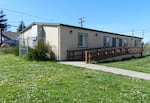
Teachers reported feeling sick in these portable classrooms at Portland's Scott School.
Cassandra Profita
In October 2012, the Oregon Occupational Safety & Health Division got a complaint about mold in a portable classroom at Scott School in Northeast Portland.
Public documents show several teachers in two adjoining classrooms reported feeling unusually sick with runny noses, eye irritation, coughing, congestion and headaches. English as a second language teacher Karen Gwaltney informed the principal that she believed mold in the portable was causing the problem.
“After staying away from the classroom for 3 days my chronic severe head pain and nasal congestion had almost disappeared,” Gwaltney wrote to principal Verenice Gutierrez. “I now have these symptoms again. My head feels as if it’s in a vice.”
Within a week, a district health official visited the portable classrooms and found carbon dioxide levels were higher than normal, the carbon dioxide sensor for the room was broken, filters on the ventilation system were dusty, and the ventilation system had been turned down.
“No air flow is in the room and windows are closed,” Portland Public Schools Safety Hazmat Coordinator Herbert Wagner wrote in an email. “We need to get some things fixed up over there for them to run again.”
The vents were cleaned, and the district hired private contractor PBS Environmental to test for mold and particulates in Gwaltney's classroom. When the results came back normal, a teacher in the adjoining classroom wrote to the district’s facilities manager.
“I would like clarification on the lab report done on Karen Gwaltney’s room, as we are having similar issues in Portable B,” wrote teacher Nicole Ansara-Henderson. “Exactly what was the air quality sample testing?”
The district soon hired PBS Environmental again to test for mold and particulates in Ansara-Henderson's classroom. Again, the results came back normal.
Patrick Wolfe, environmental health and safety manager for the district, told OSHA in a letter that the district found "no indications of a significant air quality concern" in the portables. OSHA closed the complaint.
Two months later, another OSHA complaint came in. This one noted "an unidentified air contaminant" that was "causing respiratory symptoms and skin itching among teachers" in the same two portable classrooms. Wolfe sent OSHA the results from tests taken after the the first complaint.
“My office has reached the limit of what it can do without further data,” he wrote. “We just increased the weave of the air filters for the portables air supply to further decrease particulates. Air samples do not indicate a problem, but we hoped that additional measure would somehow reconcile the situation.”
OSHA closed the file with a hand-written note: “OK response. No overexposures. Likely a personal sensitivity (not an OSHA issue). No unusual test result. Maybe an (Americans with Disabilities Act) issue.”
The Americans with Disabilities Act can be applied to people with allergies and asthma to address environmental irritants, though it wasn't in this case. Gwaltney declined to be interviewed on the record for this story, but she said her health problems were resolved after she was moved to another classroom inside the school building.
Indoor air quality regulations are scarce in Oregon. So, OSHA may have been the only state agency with any rules that apply to the situation at Scott School. Oregon OSHA spokeswoman Melanie Mesaros said her agency often finds complaints reveal workplace air quality that isn't ideal, "but it's not rising to the level of being a violation for us."
No one could pinpoint a problem in the Harvey Scott portable classrooms, but if the problem was mold, as Gwaltney suspected, OSHA rules wouldn't have been triggered.
“There are no specific OSHA rules about mold in workplaces,” Mesaros said. “Often mold is associated with dampness, lack of cleanliness, and inadequate ventilation. However, just being 'present' doesn’t necessarily make it a health concern.”
Return to main article, States Put No Limits On Use Of Portable Classrooms


